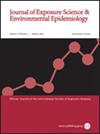产前金属暴露与早产:流行病学证据的系统回顾。
IF 4.7
3区 医学
Q2 ENVIRONMENTAL SCIENCES
Journal of Exposure Science and Environmental Epidemiology
Pub Date : 2025-01-25
DOI:10.1038/s41370-025-00744-8
引用次数: 0
摘要
背景:早产(PTB)是一种常见的妊娠并发症,与显著的新生儿发病率相关。产前暴露于环境化学物质,包括有毒和/或必需金属(样物质),可能导致PTB风险。目的:我们旨在总结产前评估的砷(As)、镉(Cd)、铬(Cr)、铜(Cu)、汞(Hg)、锰(Mn)、铅(Pb)和锌(Zn)水平与分娩时PTB或胎龄之间关系的流行病学证据;评估每种金属影响的文献质量和证据强度;并为未来的研究提供建议。方法:我们采用导航指南方法并遵循PRISMA指南。我们检索了MEDLINE/PubMed数据库1995年至2023年的流行病学研究。我们使用了定制的偏倚风险方案,并评估了每种金属(样蛋白)对肺结核风险影响的证据充分性。结果:共确定和筛选了1206项研究。其中,139项研究通过阅读全文被评估为合格,92项研究最终被纳入(砷:40,镉:30,铬:11,铜:21,汞:27,锰:17,铅:41,锌:18,金属(loid)混合物:12)。我们发现了足够的证据表明铅会增加患肺结核的风险,虽然证据有限,但有证据表明镉和铬会增加患肺结核的风险。证据被认为不足以确定对其他金属(类)的影响。意义:未来的研究将受益于更精确的PTB临床表型,在妊娠早期和整个妊娠期间测量暴露情况,使用适当的介质进行所研究的金属(样蛋白),以及评估金属混合物。鉴于有大量证据表明铅暴露与肺结核有关,有必要对孕妇进行积极和全面的产前铅暴露筛查。影响:通过总结使用严格的导航指南方法调查金属暴露与早产之间关系的92项流行病学研究,我们的综述为产前铅暴露与早产之间的紧密联系提供了令人信服的证据。此外,它还表明镉和铬暴露与早产之间存在潜在联系。鉴于这一证据的有力性质,迫切需要对怀孕期间的铅暴露进行产前筛查,并采取有针对性的干预措施以减少暴露。这些行动对于促进孕产妇和儿童健康至关重要。本文章由计算机程序翻译,如有差异,请以英文原文为准。

Prenatal metal(loid) exposure and preterm birth: a systematic review of the epidemiologic evidence
Preterm birth (PTB) is a common pregnancy complication associated with significant neonatal morbidity. Prenatal exposure to environmental chemicals, including toxic and/or essential metal(loid)s, may contribute to PTB risk. We aimed to summarize the epidemiologic evidence of the associations among levels of arsenic (As), cadmium (Cd), chromium (Cr), copper (Cu), mercury (Hg), manganese (Mn), lead (Pb), and zinc (Zn) assessed during the prenatal period and PTB or gestational age at delivery; to assess the quality of the literature and strength of evidence for an effect for each metal; and to provide recommendations for future research. We adapted the Navigation Guide methodology and followed PRISMA guidelines. We searched the MEDLINE/PubMed database for epidemiologic studies from 1995 to 2023. We used a customized risk of bias protocol and evaluated the sufficiency of evidence for an effect of each metal(loid) on PTB risk. A total of 1206 studies were identified and screened. Of these, 139 were assessed for eligibility by reading the full-text, and 92 studies were ultimately included (arsenic: 40, cadmium: 30, chromium: 11, copper: 21, mercury: 27, manganese: 17, lead: 41, zinc: 18, metal(loid) mixtures: 12). We found sufficient evidence that lead increases the risk of PTB and, while the evidence was limited, suggestive evidence that cadmium and chromium increase the risk of PTB. The evidence was deemed inadequate to determine an effect for the other metal(loid)s. Future research would benefit from more precise PTB clinical phenotyping, measuring exposure early and longitudinally throughout pregnancy, using an appropriate media for metal(loid)s under study, and evaluating metal mixtures. Given the strength of evidence linking lead exposure and PTB, active and comprehensive prenatal screening for lead exposure among pregnant individuals is warranted.
求助全文
通过发布文献求助,成功后即可免费获取论文全文。
去求助
来源期刊
CiteScore
8.90
自引率
6.70%
发文量
93
审稿时长
3 months
期刊介绍:
Journal of Exposure Science and Environmental Epidemiology (JESEE) aims to be the premier and authoritative source of information on advances in exposure science for professionals in a wide range of environmental and public health disciplines.
JESEE publishes original peer-reviewed research presenting significant advances in exposure science and exposure analysis, including development and application of the latest technologies for measuring exposures, and innovative computational approaches for translating novel data streams to characterize and predict exposures. The types of papers published in the research section of JESEE are original research articles, translation studies, and correspondence. Reported results should further understanding of the relationship between environmental exposure and human health, describe evaluated novel exposure science tools, or demonstrate potential of exposure science to enable decisions and actions that promote and protect human health.

 求助内容:
求助内容: 应助结果提醒方式:
应助结果提醒方式:


